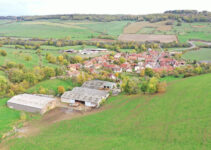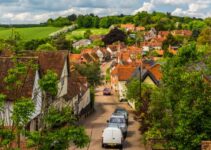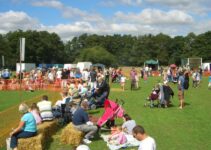Located in South West England, Devon is a beautiful county sometimes overlooked in favour of its better-known neighbour, Cornwall. However, Devon has more than enough of its own charm, making it an ideal destination for tourists and travellers wanting a taste of traditional English life.
One of the best ways to find this is by touring the prettiest villages in Devon. Like other counties, everything that Devon stands for can be found in these small rural locations. So, let’s look at some of the prettiest villages in Devon.
What is the Most Beautiful Village in Devon?
Before we get into the list, we should discuss what’s considered to be the most beautiful village in Devon.
By most standards, Dittisham is the most beautiful village in Devon. It sits on the bank of the River Dart, which experiences tidal shifts thanks to its proximity to the sea. Locals call it Ditsum, and it sits about 2 miles upstream from Dartmouth.
But what makes it the most beautiful village? Well, it features old cottages, winding hilly roads, small quays of rowboats, and plenty of other markers of traditional English charm.
There’s also a small passenger ferry that takes you to Dartmouth or across the river to Greenway Estate.
This is a good spot for history and literature lovers. Author Agatha Christie used to live there, and it’s now owned by the National Trust.
The estate is an amazing place to visit, but you have to try and tear yourself away from the beauty of Dittisham first!
The Prettiest Villages in Devon
Now that we have the most beautiful village in Devon covered, let’s look at some top contenders for the title.
It’s difficult deciding which is the best, as it ultimately depends on what you’re looking for. However, Dittisham ticks most boxes, but perhaps some of the entries below will tick even more.
So, here’s a list of some of the prettiest villages in Devon.
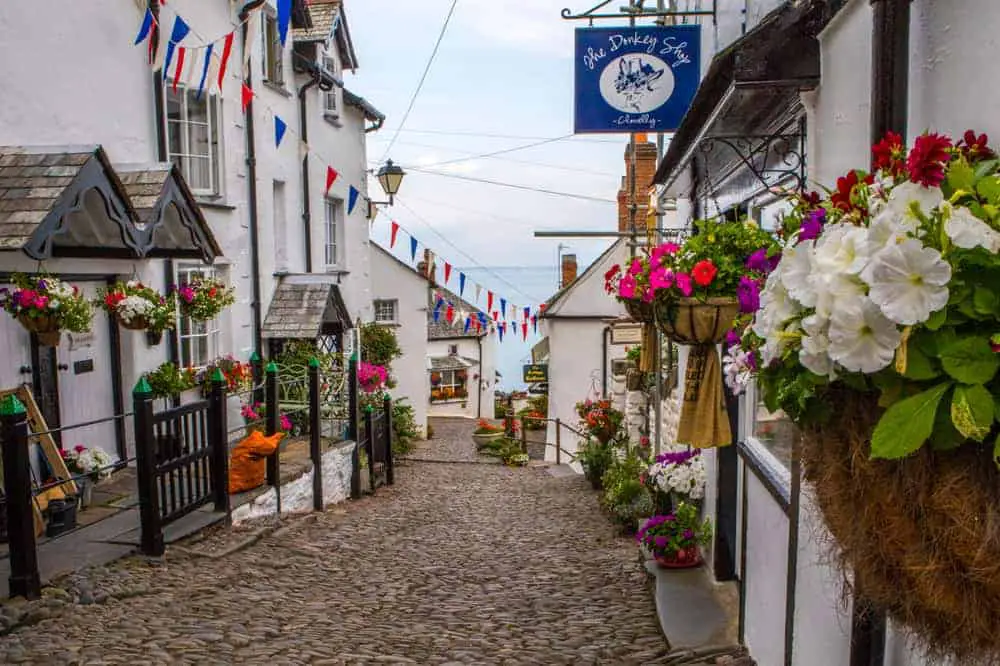
1. Lustleigh
Lustleigh is a pretty ancient village nestled away in Dartmoor. It’s located in an area called Lustleigh Cleave, which is a big valley with the River Teign running through it.
If you know anything about Dartmoor, you’ll know it’s an ideal site for hiking, and there are few better places to start than Lustleigh.
Occupation of the site goes back long before records began, and the first time it’s mentioned is in 899AD in a king’s will. However, there are signs of older settlements, including stone hut circles, a burial mound, and an ancient Celtic cross.
But in terms of present-day attractions, it’s got plenty of those, too. There’s a tea room and pub, and an old mine that you can tour. If you’d rather just walk around, there are plenty of amazing buildings to look at, too.
2. Croyde
You’ll find Croyde on the coast of North Devon, where it’s become a haven for surfers. The village even holds an annual surf and music festival on the weekend closest to the summer solstice. It’s more tourist-heavy than other entries on this list, which may or may not be a good thing.
Although it means there are plenty of amenities for people staying there (including campsites and holiday parks), it does mean that some of the village’s charm has been lost. But if your focus is old buildings and a nice beach, it certainly still delivers on those.
Croyde still has plenty to offer if you love traditional seaside villages. There are some great locations for walking, and you’ll obviously find a pub and plenty of nice places to eat.
If the idea of a tourist-focused hotspot puts you off, consider going in the off-season. While lots of the businesses will be shut, you’ll arguably get a more authentic experience of life in the village.
3. Cockington
The UK is famous for its funny place names, and Cockington is no exception. While it lacks the explicit rudeness of Fingeringhoe in Essex, it’s certainly got its own charm.
The village itself is anything but silly. The vast majority of its buildings are hundreds of years old and pictures of Cockington have barely changed since the 19th century.
In fact, settlement in the area dates back at least 2,500 years, as archaeologists have found evidence of two Iron Age hill forts nearby.
One of the most notable buildings in the village (which is saying something) is the pub, the Drum Inn. Despite looking like a 16th-century building, it was actually built in 1936 and was designed by Edwin Lutyens, the same architect who designed London’s Cenotaph.
It’s a Grade II listed building with a thatched roof and 16th-century-style bricks. So, even though it’s one of the youngest buildings in the village, it looks right at home among the Tudor cottages and Jacobean terrace houses.
4. Widecombe in the Moor
It might shock you to learn that Widecombe in the Moor (also styled as Widecombe-in-the-Moor) is located on Dartmoor.
Its name comes from the Old English for Willow Valley located on Dartmoor. Although it’s a small village, it’s a tourist favourite because of its character.
Despite being a tourist favourite, Widecombe in the Moor doesn’t have loads of attractions that make it stand out from other pretty villages.
This isn’t to say it’s boring but rather that it’s very quaint and traditional. Widecombe has fewer than 200 houses but is spread out over several miles.
One of the main attractions is its Cathedral of the Moors, which, despite the name, is just a normal church.
It’s really the Church of St. Pancras, but is known locally as a cathedral because it’s very large despite only serving a small population.
It was built in the 1300s and is definitely worth seeing for its great architecture.
5. Hartland
Although it sounds like it should be in the heart of Devon, Hartland is actually the county’s most north-westerly settlement.
It’s located on the northern coast where it turns from the Bristol Channel to the Atlantic Ocean. In the past, it was a major port for trade with Wales and other countries, and is home to an old and important lighthouse.
Hartland is a popular destination with walkers because it lies on the South West Coast Path. There’s some amazing scenery around the village, including rugged coastline and Hartland Point.
So, if you’re into walking trips, make sure you include Hartland on your route.
The village itself is pretty, too, and has plenty of things worth seeing. There’s a local church (the Church of St. Nectan), which has the tallest tower in Devon, and there’s also an abbey nearby that’s worth seeing.
The village’s main street was featured in the BBC drama The Night Manager, so you might recognise some of the scenery.
6. Braunton
Braunton is located in North Devon and used to be a top contender for the largest village in England. While this is no longer the case, its population of around 10,000 means it’s pretty big by village standards.
Even so, it retains all the characteristic charm you’d expect from one of the prettiest villages in Devon.
Again, if you’re into walking, Braunton is a good choice. It’s right next to Braunton Burrows, which is the largest psammosere in England.
This is the fancy name for a sand dune system, which definitely sounds less interesting. However, it’s home to a diverse range of plants and animals, so is great if you enjoy that sort of thing.
Braunton has numerous old manors, along with a traditional village green and church. It’s also considered the gateway to Devon’s surfing hotspots, including Croyde, mentioned above.
As such, Braunton is a great choice if you want to experience a mix of nature and old village charm but want access to amenities that some of the smaller locations might lack.
7. Dunsford
Dunsford is another old village in Devon; it first appeared in the Domesday Book as Dunesforda. So, even after nearly 1,000 years, its name has barely changed.
As you can probably tell, the Old English name even had the same meaning: Dunn’s ford.
The village is home to numerous thatched cottages, and even hosts events such as a summer fair, a pancake race, and an annual pantomime.
There’s a tea room and pub located near the 15th-century church, so Dunsford ticks all those boxes, too.
There’s a nearby woodland that’s home to 6 species of butterfly (among other things) and a 12th century manor called Great Fulford House.
If you want to get even more rural than Dunsford, consider visiting the nearby hamlets of Butts and Reedy. They’re each about 1 mile away in opposite directions and are so small that they’re considered part of the village.
8. Clovelly
Clovelly is a relatively small village on the northern coast of Devon. It’s a popular choice with tourists thanks to its lack of cars, wealth of traditional buildings, and the fact that it’s located on a 400ft. high cliff.
While you do have to pay to enter the village, it’s not expensive and it’s more than worth it.
Because no vehicles can access the village, everything is delivered by sledge down the cliff. This is the most practical way of getting stuff to the residents, but it’s also something worth seeing.
After all, when was the last time you went somewhere that had sledge deliveries?
As you can imagine, the village is pretty old-school in its design. There are cobbled streets, and 50 out of the 71 buildings are architecturally listed.
Clovelly is a great experience because it’s so different from almost everything else out there.
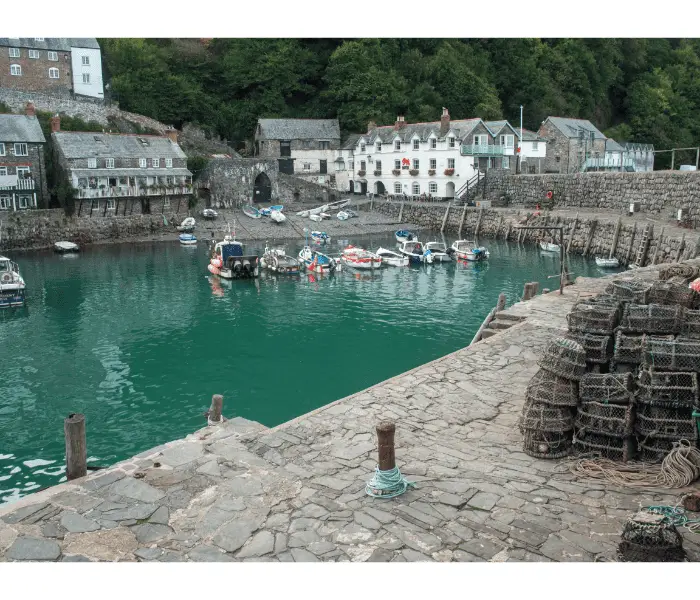
9. Lee
Also known as Lee Bay, the village is right on the northern coast of the county. In fact, it’s a mere 350 metres from the sea, meaning you can enjoy some great walks around the village and coast.
There are two coastal points nearby, both of which were the cause of many shipwrecks in the past.
One thing that stands out compared to other villages in the area is the seemingly all-service building in the centre. The Grampus is a pub, shop, and post office, meaning you can buy your groceries while enjoying a pint!
If you want to do even more walking, Lee Bay is at the foot of Fuchsia Valley, which, unsurprisingly, is used to grow fuchsia. There’s even a flower festival held in Lee’s village hall every summer.
10. Instow
Instow is a decently sized village on the estuary of the rivers Taw and Torridge. Just across the water is the village of Appledore, which is also worth visiting. For convenience, they’re combined under this entry on this list.
Both have fairly similar characters. They’re quaint and based along the waterfront, giving you easy access to the beaches.
Instow is home to a very rare species of orchid called the pyramid orchid, among others. So, if you’re into rare flowers, it’s a good choice.
Both villages are located on the Tarka Trail. This is a footpath trail around North Devon that follows the route used by Tarka the Otter in the Henry Williamson novel.
The path is about 180 miles long in a figure-of-eight shape and is a great way of taking in some of the more rural parts of North Devon.
Pretty Villages in South Devon
So far, we haven’t mentioned many villages in South Devon. That’s because, to an extent, they deserve their own consideration.
South Devon is more similar to Cornwall than North Devon, although natives might disagree with that statement!
Either way, here’s a rundown of some pretty villages in South Devon.
1. Cornworthy
Cornworthy is a small village in south Devon not too far away from Dittisham. Many of its buildings date from the mid-16th century onwards, as this is when it became the property of the Harris family.
In the village, you’ll find a few pubs, shops, and tea rooms – everything you’d expect from a small village. There’s also a winery nearby, which offers tours and, of course, tasting experiences.
Another site worth visiting is Cornworthy Priory, an early 13th-century nunnery. It was abandoned during the Dissolution of the Monasteries, so is little more than a ruin now. However, it’s a good site to see if you’re into English history.
2. Beer
Despite its name, Beer unfortunately has little to do with the alcoholic drink, other than you being able to visit the local pubs.
Its name instead comes from the Old English word for grove, which is still used elsewhere in place names. It was probably a reference to it being a wooded area specifically used for household needs.
Even though it’s quite an old settlement, Beer grew mainly during the smuggling age of the 17th century. Its cliff faces were ideal for smuggling coves, but it quickly switched to making its money from fishing and lace making.
A particularly big draw now is that it’s located on the Jurassic Coast World Heritage Site. As the name suggests, this is a hotspot for fossil hunters that extends along the east side of Lyme Bay.
With a bit of searching, you’ll be pulling up all kinds of fossils from the beach.
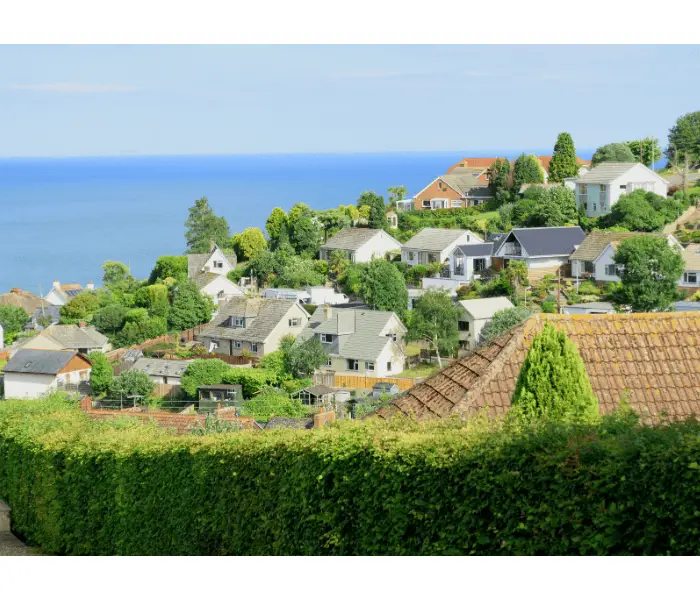
3. Littlehempston
Littlehempston is located not too far away from Cornworthy in the South Hams District. It’s about as small as a village can be before it becomes a hamlet. In the last census, it had a population of 207.
Many of the buildings are very old and are centred around the village green. There’s a local church and 2 pubs, both of which are in keeping with the local charm.
The closest town is Totnes, which you can reach on foot. In fact, there’s a footpath that extends through the woods for this exact reason. So, if you’re staying nearby, it’s certainly a walk worth doing.
Market Towns in Devon
Another type of historic settlement worth checking out is market towns. Historically, these were towns where local markets were held for the nearby villages.
As such, they follow a pretty set pattern of design and usually have some connection to a local industry, such as farming, fishing or production.
Here are some of the most notable market towns in Devon that you should visit.
1. Newton Abbot
Newton Abbot is a market town on the River Teign. It received its market charter in 1220 and has been holding markets ever since.
However, its history goes back thousands of years – there’s evidence of Neolithic settlements in the area.
Its name comes from New Town of the Abbots, as the weekly market was run by Torre Abbey. Newton Abbot grew massively in the Victorian Era thanks to its production of leather and wool. As a result, many of its most iconic buildings are from this period of history.
2. Tavistock
Tavistock is located in west Devon on the River Tavy, which is where it gets its name. As with Newton Abbot, Tavistock was granted its royal charter for markets thanks to the local abbey.
The weekly market, on a Friday, was established in 1105 and still takes place to this day.
Among other interesting sites is the birthplace of Sir Francis Drake, located just outside of the town. There are also plenty of old buildings worth seeing, including churches, the abbey, and the town hall.
3. Buckfastleigh
Unfortunately not related to the Scottish tonic wine, Buckfastleigh’s name derives from the same source. Buckfast means “stronghold”, which was a place for keeping deer.
Leigh is a word for pasture, so the name means “the pasture belonging to the stronghold”.
The town has a nearby abbey, which was founded in 1018. You can probably spot a theme here: this is what led to it being chartered as a market town.
Its primary sources of industry at this time were woollen mills, along with leather tanning and paper production.
Although Buckfastleigh rose to prominence in the Middle Ages, most of the town was rebuilt during the 17th century. The town centre still retains much of its medieval layout, though.
Nearby is Brook House Manor, a 17th-century house. While the building itself is nice, what’s more interesting is its link to Sherlock Holmes.
Arthur Conan Doyle used a local legend as his basis for The Hound of the Baskervilles. It’s claimed that when Richard Cabell (lord of the manor) died, evil hounds surrounded the manor, breathing smoke and fire.
Final Thoughts on the Prettiest Villages in Devon
Hopefully, this list will help you explore Devon to its fullest by focusing on some of the lesser-known destinations.
While the larger and more famous towns and cities are worth visiting, you can usually tell a lot more about a place by seeing its smaller villages.
Of course, it’s worth thinking about which appeal most to your tastes. No matter whether you’re into walking, wildlife, or simply old buildings, you’ll easily find plenty to do among the prettiest villages in Devon.
